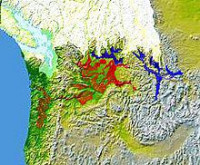|
The view of Palouse Falls here clearly shows that the erosion of the canyon is way to large to have been formed by the river flowing from the falls. Stop 2 in Pritchard and Cebula
"The oversized plunge pool and under-fit waterfall visible from the overlook effectively show that much greater forces must have formed the falls. At this stop, we will focus on the formation of the falls, Columbia River Basalt Group stratigraphy, and human history of the area."

The Missoula Floods (also known as the Spokane Floods or the Bretz Floods) refer to the cataclysmic floods that swept periodically across eastern Washington and down the Columbia River Gorge at the end of the last ice age. The glacial flood events have been researched since the 1920s. These glacial lake outburst floods were the result of periodic sudden ruptures of the ice dam on the Clark Fork River that created Glacial Lake Missoula. After each ice dam rupture, the waters of the lake would rush down the Clark Fork and the Columbia River, flooding much of eastern Washington and the Willamette Valley in western Oregon. After the rupture, the ice would reform, creating Glacial Lake Missoula again.






 Please share your ideas with us.
Please share your ideas with us.